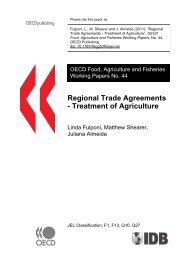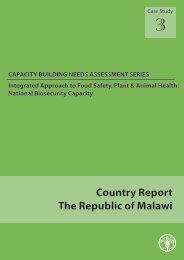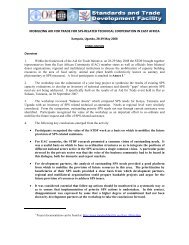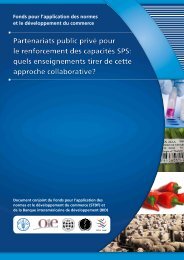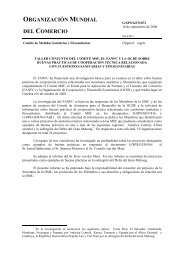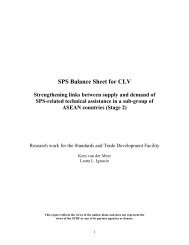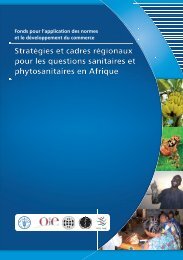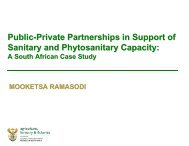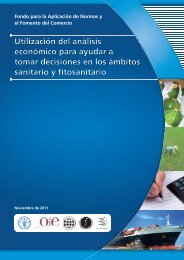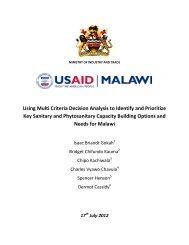Kenya - Standards and Trade Development Facility
Kenya - Standards and Trade Development Facility
Kenya - Standards and Trade Development Facility
You also want an ePaper? Increase the reach of your titles
YUMPU automatically turns print PDFs into web optimized ePapers that Google loves.
espect to enforcement of local st<strong>and</strong>ards, the FVO still raised a number of concerns in relation to sanitarycontrols, in particular in relation to their equivalence with EU legislation in areas such as the ability to test forhistamine <strong>and</strong> heavy metals.6. SPS issues remain an absolute block for access to many markets for the livestock sector, a drain onproductivity <strong>and</strong> threat to livelihoods for small farmers. The continued prevalence of important animaldiseases for livestock trade, weak veterinary infrastructure, facilities <strong>and</strong> services, low rates of investment inslaughterhouses, meat processing <strong>and</strong> distribution services mean that <strong>Kenya</strong>’s meat export opportunities arelimited to intra-regional trade, mainly in live animals. The on-going efforts of the <strong>Kenya</strong>n Government,Department of Veterinary Service, the Dairy Board <strong>and</strong> private sector to improve the animal health situation<strong>and</strong> to support the sector in line with international st<strong>and</strong>ards need to be further supported.7. The decline in coffee exports, one of <strong>Kenya</strong>’s major traditional cash crops, has been exacerbated bypest <strong>and</strong> disease problems. A main export earner <strong>and</strong> a means of livelihood to several hundred thous<strong>and</strong>people, the sector has contracted by half during the last 20 years. Factors attributed to the decline are mainlyrelated to commodity price decline, competition in the world coffee market, inefficiency in marketarrangements <strong>and</strong> other issues. Against this background of economic downturn, the ability to control pests,diseases <strong>and</strong> weeds has also declined, so exacerbated the production downturn.8. Food-borne diseases remain a problem in <strong>Kenya</strong>. Up to 70% of all episodes of diarrhoea may beattributed to ingestion of contaminated food <strong>and</strong> water. The most prevalent diseases in the year 2004 weretyphoid dysentery <strong>and</strong> gastroenteritis, which affected 643,151, 600,660, <strong>and</strong> 722,275 people respectively.Others include aflatoxin poisoning (323), brucellosis (198) <strong>and</strong> cholera (68). Some of these are seasonal <strong>and</strong>require adequate planning for preventive response. For example, aflatoxin poisoning prevalence peaks duringfood shortages <strong>and</strong> rainy seasons preceded by drought conditions within specific regions, while typhoid peaksmainly during the rainy seasons. In addition, available statistics are not well documented <strong>and</strong> processed foruse in decision-making. Investigations into causative factors <strong>and</strong> magnitudes of exposure to trigger theirmanagement are inadequate <strong>and</strong> require strengthening.9. The burden of food-borne disease also creates a difficulty in the service sector, in particular for thetourism trade. The tourist sector’s backward linkages related to the supply of safe food, hygiene <strong>and</strong>sanitation issues need to be properly addressed. For income from visitors to be maximized <strong>and</strong> the likelihoodof return visits increased, food-borne risks need to be reduced.10. <strong>Kenya</strong>’s successful penetration of the EU market, in particular for cut flowers <strong>and</strong> fresh vegetables,can mask its equal success in exp<strong>and</strong>ing south-south trade. A growing range of primary <strong>and</strong> value-addedproducts is going to the East African Community (EAC), the Common Market of East <strong>and</strong> Southern Africa(COMESA), the Middle East, Asia, Russia, Israel <strong>and</strong> other markets. In particular, <strong>Kenya</strong> has takenadvantage of the improved trading opportunities afforded by the East African Customs Union <strong>and</strong> COMESA.Continued diversification both in the range of products traded <strong>and</strong> markets need to be further strengthened.Key in this respect is supporting the private sector associations which have been so prominent in driving thesuccess development of their sectors (horticulture, fish, tea, etc.) <strong>and</strong> pushing for a supportive governmentpolicy environment.11. Based on existing capacity assessments <strong>and</strong> evaluations, the following priority areas emerge as notbeing currently addressed by the existing or planned donor programmes. Addressing these areas would helppoverty alleviation by reducing the burden of animal disease <strong>and</strong> plant pests so increasing small farmerincome, generate additional export revenue, <strong>and</strong> reduce the burden of food-borne disease in the population<strong>and</strong> on the economy.• Tackle pest problems limiting expansion in the floriculture <strong>and</strong> horticulture sectors, in particular dueto fruit fly, exp<strong>and</strong> small-holder certification schemes into new production areas <strong>and</strong> product groups,3



